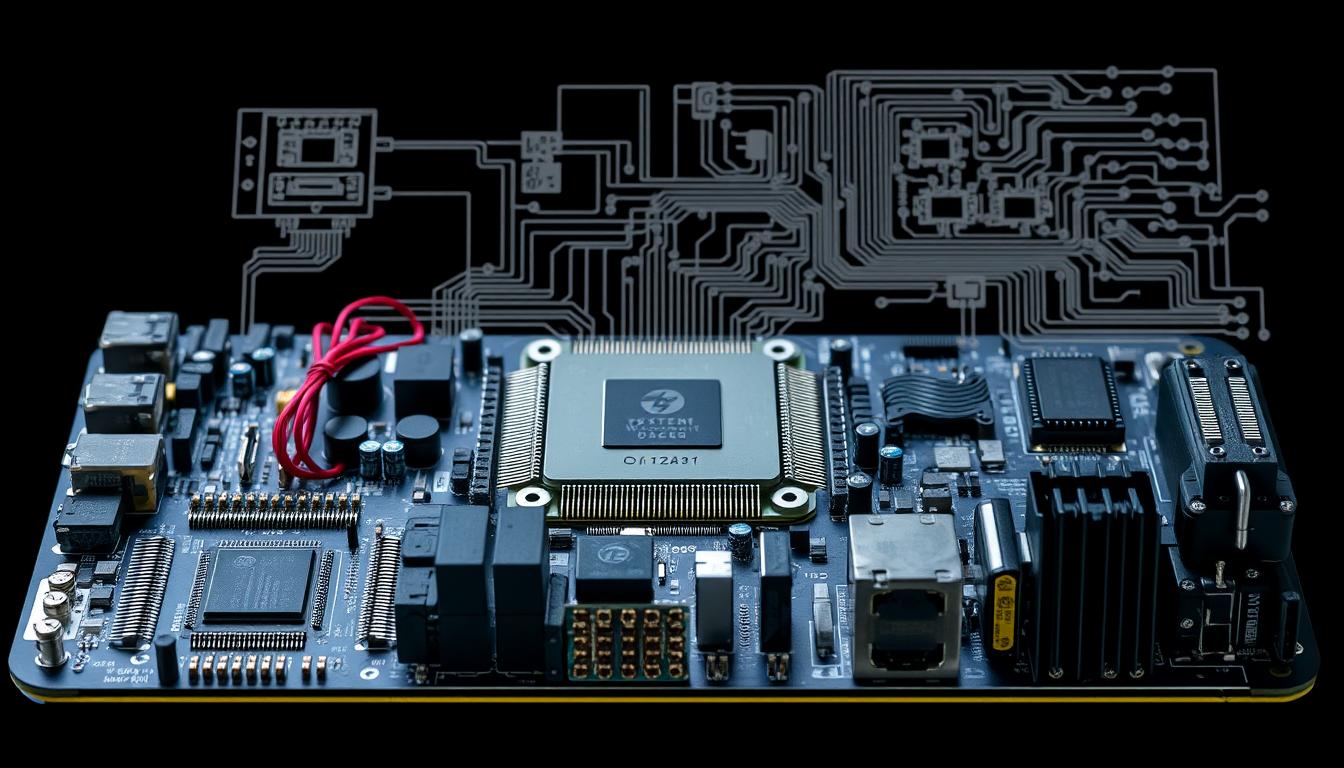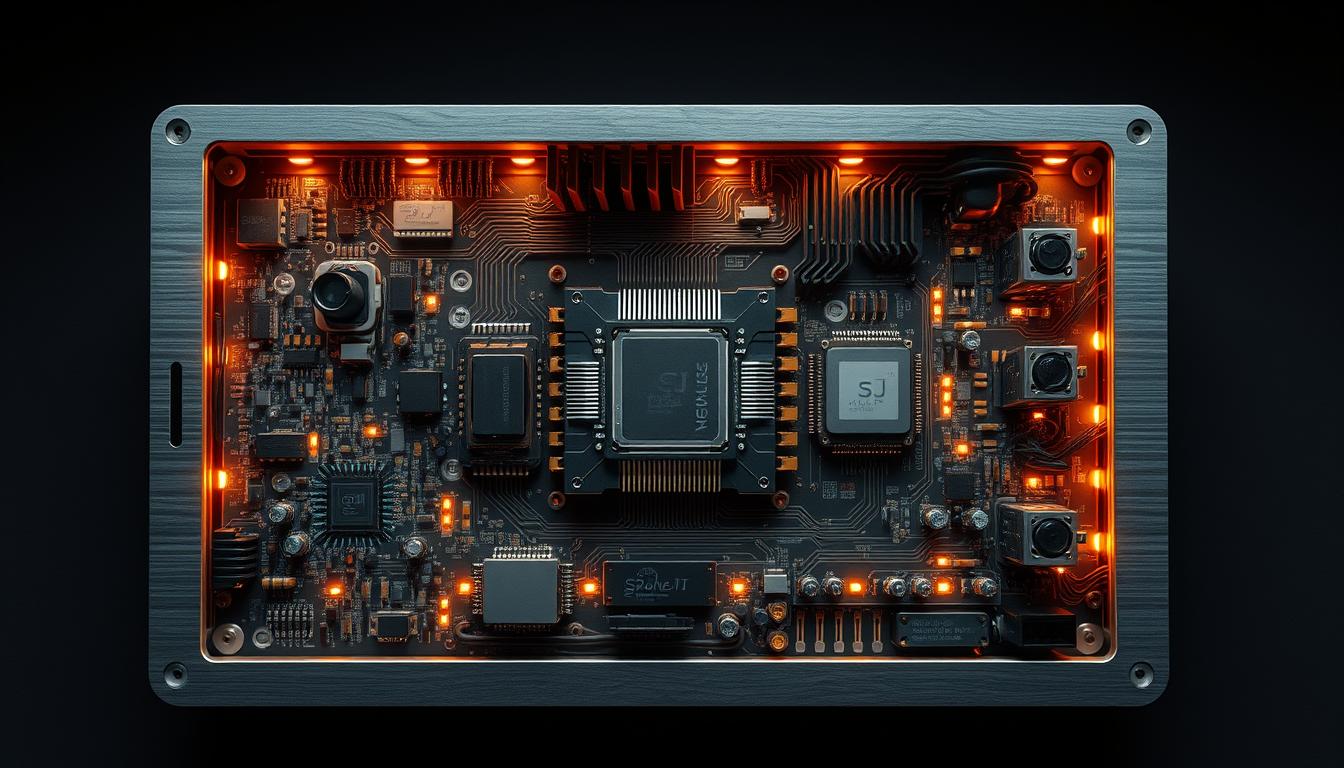Embedded systems: a complete guide and applications
Embedded systems, ubiquitous in our daily lives, are miniature, specialized computers. They hide in our smartphones, cars, medical devices and household appliances. These little geniuses silently manage a multitude of essential tasks, from temperature control to automotive safety.
On-board electronics reign supreme: 98% of consumer electronic devices incorporate them. In the automotive sector, it controls more than 80% of modern vehicle functions. The market, valued at $125 billion in 2022, is expected to reach $200 billion by 2027.
These systems excel in energy efficiency, consuming 30% less than traditional computers. This makes them ideal for stand-alone or battery-powered applications. A major asset in our mobile and connected world.
Key points to remember
- Embedded systems are present in 98% of electronic devices
- They control 80% of modern vehicle functions
- Market expected to reach $200 billion by 2027
- They consume 30% less energy than conventional systems
- 70% of embedded systems are designed for real-time applications
- 60% of developers use C for programming
Definition and fundamental principles
Embedded systems are ubiquitous in our daily lives. These specialized computing devices perform specific tasks autonomously. Their real-time operation makes them indispensable in many devices.
What is an embedded system
An embedded system combines hardware and software for a specific function. It is integrated into a larger device, such as a smartphone or a vehicle. These systems use microcontrollers to process information and interact with the environment.
Key features
Low energy consumption is a key feature of embedded systems, especially for portable devices. Their design ensures reliability and operation under a wide range of conditions. Real-time responsiveness is essential for certain applications, such as automotive braking systems.
Types of embedded systems
Embedded systems fall into several categories according to their specific functions:
- Real-time systems: for critical applications requiring immediate response
- Autonomous systems: operating without human intervention
- Networked systems: communicating with other devices
These systems permeate diverse sectors, from consumer electronics to industry. Their presence also extends to the healthcare and automotive sectors. Their versatility and efficiency make them indispensable in our modern technological environment.
Embedded systems in our daily lives
Embedded systems are omnipresent in our daily lives. They are hidden in 98% of the electronic devices we use every day. From alarm clocks to smartphones, these discreet technologies enhance our comfort and efficiency.
The Internet of Things (IoT) relies heavily on these systems. By 2025, 75 billion connected objects will incorporate embedded systems. Our homes, cars and cities will become intelligent, interconnected spaces.

In the automotive industry, on-board systems account for 40% of overall costs. They ensure vehicle safety, comfort and energy efficiency. In healthcare, these systems are revolutionizing wearable medical devices.
They offer constant, personalized patient monitoring. The embedded systems market is expected to grow by 5% a year until 2028.
SectorApplication of embedded systemsImpactAutomotiveNavigation systems, assisted brakingImproving safety and comfortHealthWearable medical devicesPersonalized patient monitoringDomoticsIntelligent thermostats, automated lightingOptimizing energy consumption
Estimated at $150 billion by 2023, this market continues to innovate. It is transforming our daily lives, creating a more connected and intelligent world.
Hardware architecture of embedded systems
Hardware architecture is the foundation of embedded systems. It encompasses the vital components that enable them to function optimally in a variety of domains. Let's discover the essential elements of this captivating architecture.
Microcontrollers and microprocessors
Microcontrollers are essential for embedded electronics. These chips integrate processor, memory and I/O interfaces on a single circuit. They are optimized for specific tasks and low power consumption.
Microprocessors offer more computing power. However, they require external components to operate efficiently.
Memory and storage
Memory management is crucial in embedded systems. A distinction is made between volatile memory (SRAM, DRAM) and non-volatile memory (ROM, Flash). The choice depends on performance and power consumption requirements.

Input/output interfaces
I/O interfaces enable embedded systems to interact with the environment. They include serial ports, communication buses and wireless interfaces. These components are essential for integrating the system into its context of use.
Peripherals and sensors
Peripherals and sensors enhance the capabilities of embedded systems. They collect data, control equipment and facilitate user interaction. Sensor selection depends on the target application and system constraints.
ComponentFunctionApplication exampleMicrocontrollerCentral controlSmart thermostatFlash memoryNon-volatile storageSmartphone firmwareUSB portCommunication interfaceData transfer in a cameraTemperature sensorEnvironmental measurementAutomotive climate control
Embedded systems programming
Embedded programming is essential to the design of embedded systems. It requires mastery of specific languages and tools. This fascinating discipline demands a high level of expertise.
Programming languages used
The choice of language is crucial in embedded programming. C dominates, with 75% of developers adopting it for its efficiency. C++ is gaining ground, used by 30% of developers.
Java is used in 40% of Internet applications. Python is emerging in 15% of IoT projects, offering new possibilities.
Development environments
IDEs are essential for designing embedded systems. They provide powerful tools for writing, compiling and debugging. Eclipse, Visual Studio and Arduino IDE are popular choices.
Debugging and testing
Debugging and testing guarantee the reliability of embedded systems. Debugging tools track down errors. Tests verify operation under various conditions.
60% of engineers consider mastery of the language to be crucial. Embedded programming is constantly evolving, adapting to technological innovations.
Communication technologies
Embedded systems are essential to the Internet of Things. They use a variety of technologies to communicate. LoRa, GNSS, Wi-Fi and Bluetooth enable devices to exchange data.
LoRa excels in long-range, low-power transmission. GNSS offers precise geolocation for transportation applications. Wi-Fi and Bluetooth ensure fast connections for home connected objects.
These technologies stimulate innovation. In home automation, embedded systems manage lighting and heating. In industry, they optimize production and predictive maintenance.
Connected vehicles use these protocols to improve road safety. Syscom-Prorep offers customized connectivity solutions. Their modules integrate these technologies for high-performance on-board systems.
Real-time operating systems (RTOS)
RTOS are essential in embedded systems. They guarantee fast responses for a wide range of everyday and industrial applications. Their unique design makes them indispensable in many advanced technological fields.
RTOS features
RTOS excel at managing the response time between stimulus and action. Their sophisticated scheduling techniques optimize task management efficiently.
Priority-based systems react only to critical events. Sharing systems, on the other hand, offer more predictable, structured multitasking.
Main RTOS on the market
The RTOS market offers over 100 different options. There are 54% open-source and 46% proprietary solutions. FreeRTOS, VxWorks, QNX and RTEMS are popular choices.
The majority of active RTOSes target embedded systems. They offer extensive support for ARM and x86 architectures, meeting specific needs.
RTOS selection criteria
Selecting an RTOS depends on the specific requirements of the project. Key criteria include supported architecture, memory footprint and real-time functionality. Licensing options should also be carefully considered.
For embedded applications, the RTOS must adapt to resource constraints. It must also meet system performance requirements in an optimal way.
RTOS are everywhere, from thermostats to industrial robots. Their constant evolution meets the challenges of modern applications. They ensure optimum performance in the most demanding environments.
Industrial and IoT applications
Embedded systems are transforming industry and the Internet of Things. Their influence extends to many fields, changing the way we live and work. This technological revolution is redefining the way we live and work.
Industry 4.0
Industry 4.0 ushers in a new era of industrial production. Embedded systems are essential to this, enabling real-time data collection. This revolution began in 1967 with the first guidance system for the Apollo spacecraft.
Home automation and intelligent buildings
In our homes, embedded systems are transforming appliances into connected objects. Refrigerators with temperature sensors exemplify this evolution. Voice assistants like Amazon Echo centralize control of connected appliances, optimizing the efficiency of our homes.
Transport and automotive
On-board systems are ubiquitous in the automotive industry. From ABS systems to autonomous cars, they enhance safety and comfort. These critical systems analyze radar and camera data for safer driving.
The integration of embedded systems in the IoT opens up new perspectives. Industrial predictive maintenance and connected glucometers illustrate this synergy. These advances require particular attention to data security and confidentiality.
Safety of embedded systems
The security of embedded systems has become crucial in our interconnected world. These systems, present in 90% of modern electronic devices, are frequently targeted by cyber attacks. By 2023, 70% of attacks will target embedded systems, threatening the reliability of critical equipment.
The risks are considerable. Half of all companies using these systems have recently suffered a security breach. The average cost of an attack is 3.86 million euros. More alarmingly, 60% of attacks originate from within organizations.
- Locking communication interfaces
- Disabling non-essential firmware functions
- Implementation of regular update policies
- Communication encryption with secure algorithms
- Training employees to manage cyber incidents
The reliability of critical systems depends on robust security measures. Regular audits, based on standards such as ISO-27001, are essential. Continuous monitoring via SIEM systems enables early detection of incidents.
By investing in security, companies protect their embedded systems and safeguard their reputation. This proactive approach strengthens their financial and operational position in the face of growing threats.
Syscom-Prorep solutions for embedded systems
Syscom-Prorep excels in embedded systems and electronics. With sales of 24 million euros in 2020, the company offers complete solutions. It meets the needs of over 700 customers in leading-edge sectors.
Product range
The company offers 21 models in 6 categories. Products include fixed and handheld barcode scanners, microkiosks and OEM reading modules. Handheld computers and tablets complete the range.
These embedded systems are suitable for a wide range of industrial and professional uses. They meet the varied requirements of customers in different sectors.
Integration services
Syscom-Prorep does more than just sell products. The company offers customized integration services for embedded systems. It customizes its display solutions and batteries to specific needs.
What's more, Syscom-Prorep offers component sourcing tailored to each customer's unique projects. This approach guarantees solutions perfectly aligned with user requirements.
Technical support
Comprehensive technical support is at the heart of the Syscom-Prorep offering. This approach, combined with a dynamic growth strategy, keeps the company at the forefront of innovation.
With 6 strategic acquisitions, Syscom-Prorep strengthens its position in embedded electronics. Its commitment to digital transformation makes it a preferred partner for the most demanding projects.
FAQ
What is an embedded system?
An embedded system is a specialized computer integrated into a larger device. It performs specific tasks with low power consumption. Its reliability and ability to operate in real time are its major assets.
What are the main features of embedded systems?
Embedded systems are distinguished by their low energy consumption and reliability. They operate in real time and are autonomous. Their specialized nature makes them ideal for integration into larger systems.
Where can we find embedded systems in our daily lives?
Embedded systems are ubiquitous in our daily lives. They can be found in smartphones and intelligent household appliances. Car navigation systems and connected watches are also equipped with them.
What's the difference between a microcontroller and a microprocessor?
A microcontroller is a complete system-on-a-chip, ideal for specific tasks in embedded systems. It integrates processor, memory and peripherals. A microprocessor is primarily a processing unit requiring external components.
What are the most widely used programming languages for embedded systems?
C, C++ and assembler are the most widely used languages for embedded systems. Python and Java are gaining in popularity for specific applications.
What is a real-time operating system (RTOS)?
An RTOS is designed for real-time applications. It ensures that critical tasks are carried out within precise deadlines. This feature is essential in automotive, aerospace and industrial applications.
How do embedded systems contribute to the Internet of Things (IoT)?
Embedded systems are crucial to the IoT. They provide intelligence and connectivity to objects. They enable data collection and local processing. Their communication with other devices creates a network of interconnected intelligent objects.
What are the safety challenges specific to embedded systems?
Embedded systems face unique security challenges. Protection against intrusion and data theft is paramount. Secure communications and authentication are also crucial.
What are the applications of embedded systems in Industry 4.0?
In Industry 4.0, embedded systems automate processes. They provide predictive maintenance and monitor equipment in real time. Their energy management and the creation of digital twins make factories smarter.
How does Syscom-Prorep contribute to the field of embedded systems?
Syscom-Prorep offers innovative connectivity solutions and display systems. The company supplies industrial PCs and module-based systems. It also offers customized integration services and comprehensive technical support.

